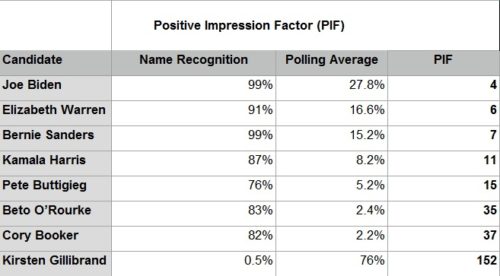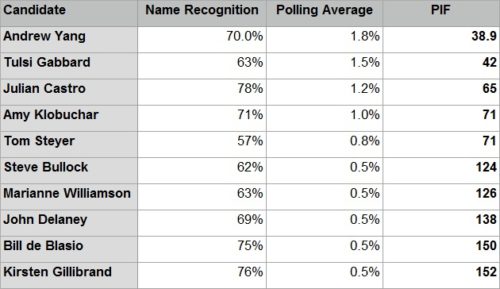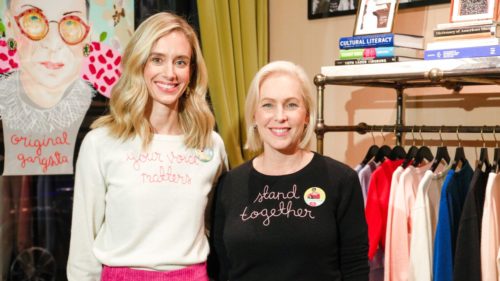Kirsten Gillibrand isn’t going to win the Democratic nomination in 2020. And she probably won’t even win a single delegate. Even former staffers are calling her campaign ‘obnoxious and performative’ and asking her to quit the race. As a result, my own guidelines might suggest I shouldn’t write a post about her campaign. But I’m going to write about it anyway. I’m going to do it because I think she’s centering her campaign on an idea no one else has ever taken up for a major national campaign. That idea is gender-identitarianism.
Let’s explore this in more depth.
Gillibrand’s Campaign and Gender-Identitarianism
I wrote much earlier about identitarianism, so I won’t reinvent the wheel. But the gist of it is this. Identitarians reduce politics to identity in a way roughly analogous to how libertarians reduce politics to liberty. They reduce it to either one aspect of identity, e.g., race or gender, or all identities, i.e., intersectionality. It’s a specific kind of identity politics, and it’s a form with a deep history on the US political right but a much briefer one on the US political left.
And so, my first question here is whether Gillibrand’s campaign is geared around gender-identitarianism. Does she reduce politics to gender?
Gillibrand’s Career
Gillibrand started as a corporate lawyer. And not an especially political or liberal one, working for a corporate law office and later becoming a partner in one. Not long before her stint in Congress, she became the leader of the Women’s Leadership Forum, a generic corporate feminist and Democratic political org. Hillary Clinton was Gillibrand’s political mentor.
Gillibrand joined the Blue Dog Coalition after she won a seat in Congress in 2006. She served as a center-right Democrat from Upstate New York through 2+ House terms. In particular, she served as an anti-immigrant Democrat. After her appointment to the US Senate in 2009, she gradually moved to the left. Especially after winning her own term in 2012, and especially after Donald Trump won the presidency. These days, she endorses much of the Sandersista Trinity, as well as other ‘progressive’ legislation, as a part of her presidential campaign.
While she’s moved significantly to the left, there are some common themes that never changed for her. She’s always shown concern for the status of women, in at least some sense. She opposed sexual harassment and assault in the military even during her center-right House days. And she rather famously pressed Al Franken to resign during their time in the Senate. More on that below.
Her campaign theme – ‘Brave Wins’ – is clearly a nod to both the #MeToo movement and Gillibrand’s own work combating sexual harassment and assault.
Image and Base of Power
There’s the image aspect of campaigns. When you click on Gillibrand’s website, it immediately meets you with a wall of pink. But this goes well beyond the superficial. After clicking through the pink screen, ‘Fighting for Women and Families’ is the first issue in her list. And if you’re an Iowan, you’ll notice the pink shirts her volunteers wear and her frequent references to gender in her campaign message. Hard to miss. Oh yeah, and that one tweet. And if you somehow manage to miss all this, there’s her campaign memos.
It’s not subtle.
She doesn’t do well in the polls, which I’ll address below. But when polls provide demographic details, she does about twice or three times better among women than men.
She also focuses her legislative agenda on the status of women and trans people. She’s introduced legislation protecting trans people in the military, protecting women from sexual assault on college campuses, and a Family Bill of Rights including provisions for maternal health care, expanded adoption rights, nursery rights, an expansion of the Children’s Health Insurance Program, and affordable child care. She also frequently discusses abortion.
Gender-Identitarianism or Intersectional-Identitarianism?
So, there are two reasons why I think Gillibrand’s campaign hits the theme of gender-identitarianism. One, she spends the vast majority of her time and resources talking about issues specifically related to gender. While she’s endorsed other things, she doesn’t spend a lot of time talking about them or working on them. The image and messaging always remain close to gender. Even though in many cases she endorses proposals already contained within the broader, movement-ready legislative proposals of her rivals, like the Sanders Medicare for All bill.
Two, while she gives the occasional nod toward intersectionality, this is really a gender-focused campaign. Her most commendable nod to intersectionality came at a campaign event in Ohio, where Gillibrand fielded a question from a woman about white privilege. She spoke to institutional racism and some of the specific issues black women face related to maternal mortality, et al. While this shows a certain attention to intersectionality, this is really more exception than norm.
A Brief Clarification
I want to emphasize here that I’m not suggesting there’s anything particularly inauthentic about Gillibrand or her campaign. For example, some accuse Gillibrand of using gender identity in racially-offensive ways. Others accuse her of using identity issues as a cover for an underlying commitment to some kind of corporate neoliberalism.
Notably, these accusations, including both the links above, come from the political right. While it’s probably fair to toss these kinds of accusations toward, say, the Hillary Clinton 2016 campaign, they don’t appear true of Gillibrand. She seems genuinely committed to (at least most of) the things she says. That’s part of why I find her campaign compelling enough to write about. It’s gender-identitarianism that isn’t simply a cover for neoliberalism.
Just How Badly is Gillibrand Doing?
Lots of candidates are performing badly in the polls. But no one is performing as badly as Gillibrand, all things considered. I’ll demonstrate this.
One way to measure how a candidate’s performing is to plot their name recognition against their polling. For lack of a better way of putting it, we might call this the ‘Positive Impression Factor’. That is to say, among voters who know about a person, how many are persuaded to vote for them?
Well, I ran the numbers on this. For name recognition, I used Morning Consult‘s weekly survey. And for polling averages, I used the polling aggregation at 270 to Win.
Here’s how Gillibrand does in comparison to the 7 candidates who, at least on my reading, have at least some chance of winning the nomination. The score on the right is the one to watch, and a lower number is better.

Gillibrand is way behind everyone, but you might ask whether this is fair. Why not compare Gillibrand to the other minor candidates rather than to the candidates doing well? OK, fine. Here’s the graphic for that.

Not much better. Again, Gillibrand is in last place. Even worse than de Blasio, Delaney, and Williamson.
Why is Gillibrand Doing So Badly?
OK, we’ve got it. She’s way behind, and she’s not going to win. Why? I think there are three possibilities, and I’ll work through them.
First, there’s the Al Franken incident. Did sexist backlash, the Ghost of Franken, ruin her campaign? Here’s what we know about the incident. Numerous women credibly accused Franken of groping them, non-consensual kissing, et al. Gillibrand was Franken’s first Senate colleague to call for him to resign, and then 35 Democratic colleagues joined her. Lots of Democrats hold a grudge against her for being the first to push Franken, and so the claim here is that this grudge is the reason she’s losing.
While I suspect this kind of sexism might explain, in part, why Gillibrand struggled in early fundraising, it’s tough to see how this explains why she continues polling under 1 percent. I’d think solidarity with Gillibrand might be worth at least a few percent, even if sexism did prevent her from winning the nomination outright.
Second, there’s the more general issue of sexism and the media. Maybe the press shorts Gillibrand on message coverage. The Guardian once raised the possibility, and some of the criticism of her contains sexist elements. Kate Manne, author of Down Girl, cites sexism as a general reason why men led women in early polling.
But sexism in general doesn’t say much about why Gillibrand performs poorly. Maybe it explains why white men are doing well, or maybe it doesn’t. Either way, it doesn’t say a lot about why Gillibrand trails Elizabeth Warren and Kamala Harris. And Tulsi Gabbard, Amy Klobuchar, and Marianne Williamson. She’s in sixth place among women.
It’s the Gender-Identitarianism
I think this leaves us with the best explanation for why Gillibrand is doing so badly: voters aren’t interested in gender-identitarianism as a political ideology. Aside from perhaps certain small subgroups of ‘second-wave feminism‘, and certain subgroups of Teen Vogue readers, it’s not a popular view.
Why?
I find this difficult to answer. The optimist in me says voters reject it because it’s a bad view. It imports various myths about the status of gender and the explanatory role of gender in society. But the pessimist in me says voters reject it because of the continuing influences of sexism and misogyny in society. Basically the reasons someone like, say, Kate Manne might give.
I’ll invite the reader to consider this question, too.
Will Gender-Identitarianism Ever Have Its Moment?
This, too, is an open question. My sense is that intersectional-identitarianism is much more likely to take off as an organizing ideology. Particularly among wealthier youngsters.
